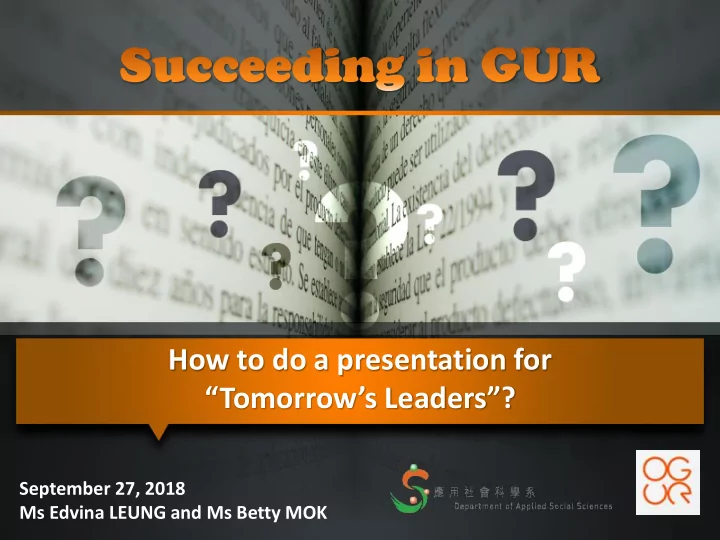

How to do a presentation for “Tomorrow’s Leaders”? September 27, 2018 Ms Edvina LEUNG and Ms Betty MOK
• Lecture 9 - 13 • Each group will work on ONE chosen attribute of an effective leader (e.g., emotional competence, resilience) • Conducted in English • 30 minutes (including Q&A session) 2
• Content (40%) Richness of the related knowledge in the presentation and thoroughness of the review • Higher-level thinking (40%) Depth of discussion on the theoretical issues; level of critical discussion; integration of the theories and research finding reviewed; level of reflection • Quality of the presentation (20%) Flow of arguments; division of labor; ability to engage the classmates; ability to complete the presentation within the allocated time
Review the conceptions and definitions of the 1 chosen attribute Review one theory or model about the nature 2 of the chosen attribute Present research findings and/or arguments 3 from two empirical studies showing the importance of this attribute Discuss two ways by which the attribute can be 4 strengthened 5 Reflection on the topic 4
Review the conceptions and definitions of the 1 chosen attribute • Definitions: the attribute has to be defined in an academic way • How scholars interpret the attribute • Supported by journal articles or books • Not by Wikipedia • How do different scholars define the attribute? • What are some similarities and differences between the definitions? • What is your group’s own definition of the attribute? 5
Review one theory or model about the nature 2 of the chosen attribute Theory • Explanation of an incident/event with empirical testing and evidenced results. • These results are accepted by most of the professional scholars in the respective field. 6
Review one theory or model about the nature 2 of the chosen attribute Model • Representation (verbal, visual and mathematical) of the scientific processes or structures and allowed the professional scholars to test on. 7
Present research findings and/or arguments 3 from two empirical studies showing the importance of this attribute EMPIRICAL STUDIES • Hypothesis • With theory/theories supported • Empirical measurements: Quantitative/Qualitative methodologies • Results and discussion • Case studies • Research findings showing the importance of the attribute: Having the attribute is related to better outcomes 1. Lacking the attribute is related to worse outcomes 2. 8
9
10
11
12
13
14
1. Aims and objectives Why was the study conducted? What the scholars want to investigate? 2. Methodology Quantitative (e.g. surveys)/Qualitative (e.g. focus groups/ interviews)? Instruments used? 3. Research findings What did the researchers find from their data? The patterns yielded (e.g., relationship between variables) 4. Discussion of findings Explain the findings and why you think this study can show the importance of the attribute How does it help us understand the attribute better? 15
• Is the study related to the theories/models you presented in Part 2? • How can the findings be related to your classmates (e.g., adolescents, university students, those in your discipline)? • Any critiques on the study: Was the methodologies used good? If you had a chance to do the study over, how would you do it differently? Why? 16
Discuss two ways by which the attribute can be 4 strengthened Ways to promote that attribute • Derived from studies • Suggestions with evidence • Integrated with your own discipline What practical ways can classmates employ to enhance their attribute? 17
5 Reflection on the topic • As a group, what reflections have you gained on the topic after the presentation? • Some new insights or understanding? • How has it impacted on you? • Will you do things differently after learning more about your topic? 18
• Your course notes do not count as a source, but might be used as a starting point. • References are to be made in APA format. • In-text citations must be included in your slides. • A bibliography/ references list should be included at the end of your presentation containing ALL references that was cited. 19
• Presentation outline/materials should be equally shared among the group members. • Agreement on division of labor • Based on each group mates’ strengths and interests • Respect differences - be open to ideas • Time management - set tasks/goals and timeline • Plan ahead - do not leave things until the last minute! • Rehearse your presentation • Familiar with all parts of the presentation 20
21
Recommend
More recommend